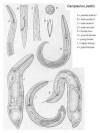
NEMATOLOGY 100 MID-TERM EXAM -- 1 1/2 HOURS
MID-TERM EXAM, 10/22/08
90 minutes
1. (20 points)
You are provided with a composite sample of nematodes extracted from a grape vineyard, a walnut orchard, and shrubs on the UC Davis campus.
a. Place one or more adult female
plant-feeding nematode of the Order Tylenchida
on a microscope slide.
(i) adult female of the Order Tylenchida.
(ii) good condition with structures of the
esophagus and stoma clearly visible.
b. Indicate on your exam sheet the
Class and Order of your nematode.
c. Draw and label the component parts of the
stylet and
esophagus for this type of
nematode (either from your specimen, or from your knowledge of anatomy and
morphology, or both).
d. Call the instructor for examination of
your nematode. If there is more than one nematode present in the microscope
field, indicate the specimen you wish to have examined. Do not ask or expect the
instructor to make the selection.
Only the nematode that you indicate
initially will be considered.
Grading:
2. (15 points)
a.
Describe the
distinguishing morphological and anatomical characteristics of the sheath
nematodes, Hemicycliophora spp.
b.
Describe the
feeding habits of the sheath nematode.
c.
How are the
survival and reproduction of Hemicycliophora
arenaria influenced by environmental conditions?
3. (10 points)
4. (15 points)
5. (15 points)
a. Briefly describe a method of separating nematodes from soil that does not require the nematodes to be motile.
b. What are the constraints of using this method?
6. (10 points)
Describe the feeding process and withdrawal of host cytoplasm by Pararichodorus allius (one of the stubby root nematodes).
7.
(15 points)
 |
The composite nematode drawing (click to
enlarge thumbnail) is extracted
from a paper by Gerald Thorne in the 1943 volume of the Proceedings of the
Helminthological Society of Washington. We did not study
this genus in class but it is a parasite of
walnut.
(i)
What is the
probable feeding habit of this
nematode? (give reasons).
(ii)
In which
order of the
Nematoda would you place this genus, and why?
(iii)
Use the appropriate letter to label
structures on the drawings. Only label each structure one time - on the
drawing in which it is most obvious.
|
|